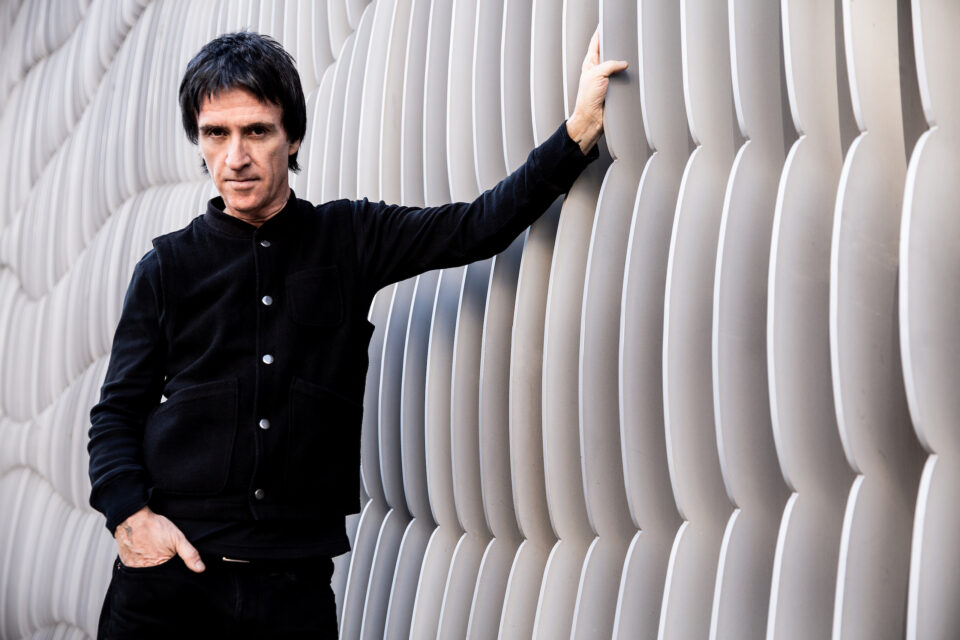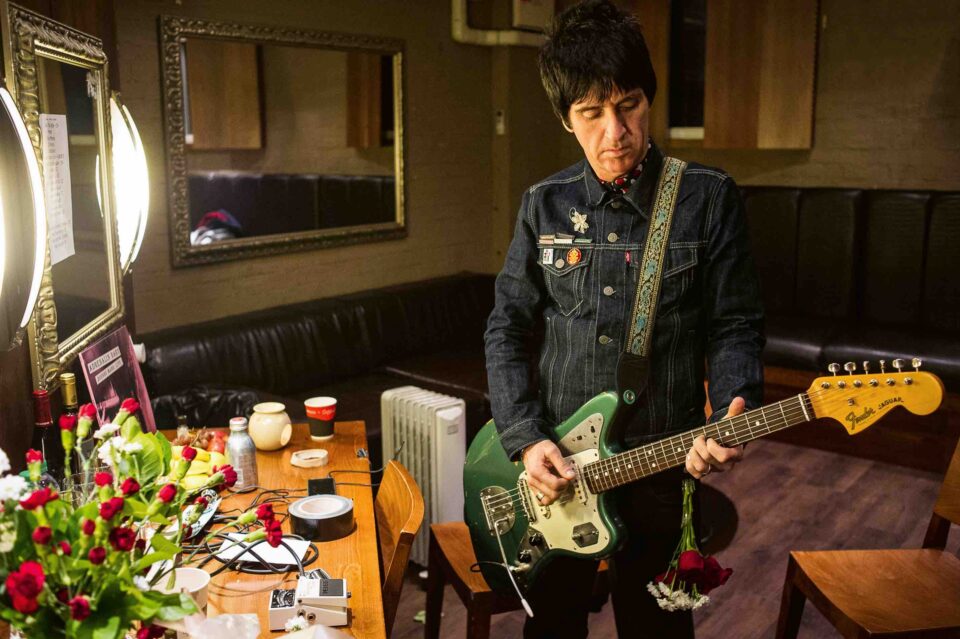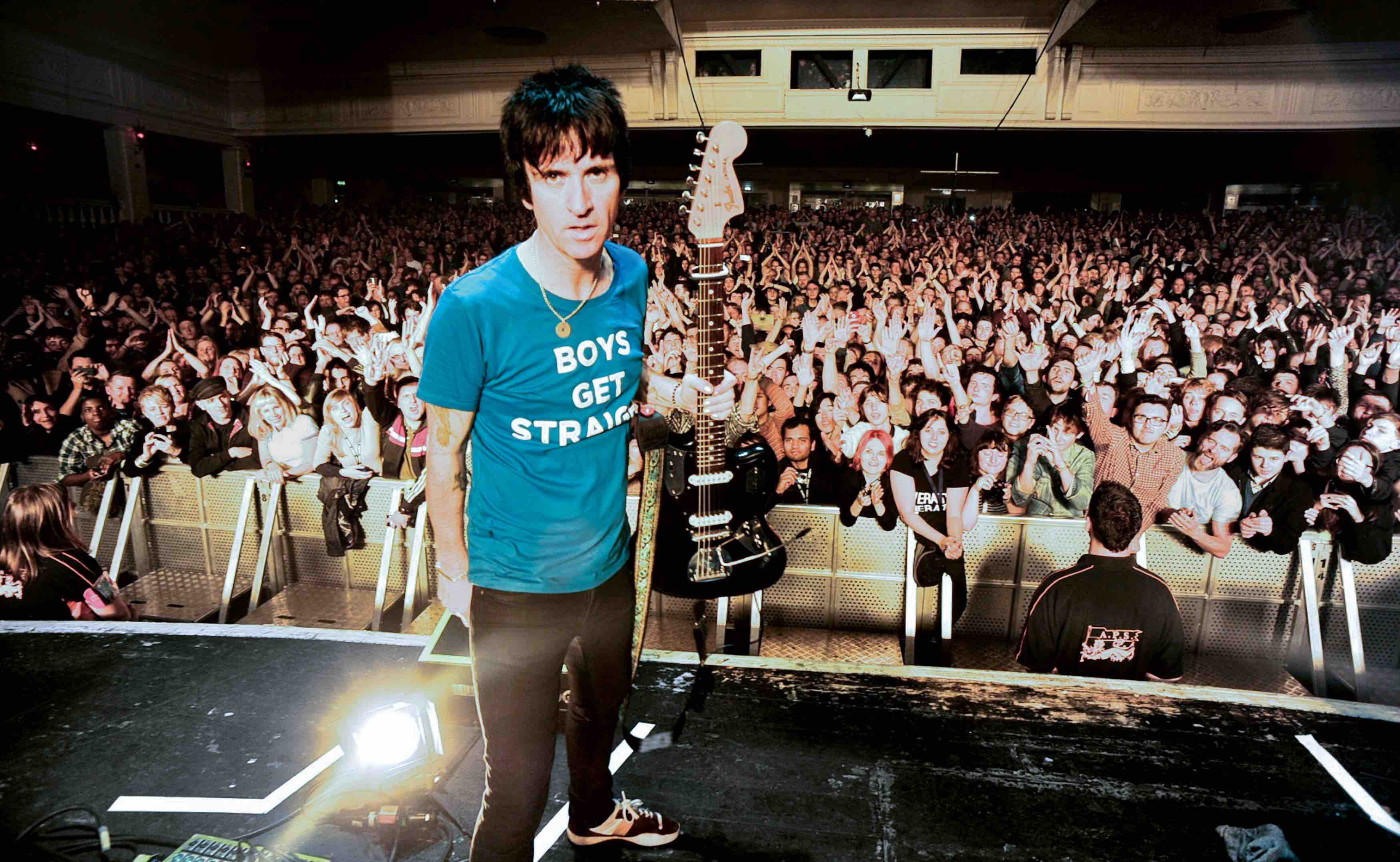When he appears on our Zoom call, Johnny Marr is in an upbeat mood. The night before, he’d held a successful event in Brooklyn to promote his new book Marr’s Guitars, which was just published last month by Dey Street Books. A previous event in Los Angeles was similarly successful, he says, with several more appearances coming up in his native UK throughout the next few months.
It’s probably not surprising that people are so interested in his book, considering it’s an intimate and fascinating look across his career via photographic portraits of his many guitars (courtesy of renowned punk photographer Pat Graham), as well as backstage and onstage shots. Alongside those photos, Marr penned essays about what these instruments mean to him, including which ones were used to create some of his most notable musical moments. He certainly has a wealth of intriguing stories to share: During his four-decade career he’s been a member of, or worked closely with, some of the most iconic artists in the rock world, including The Smiths, The Pretenders, Bryan Ferry, Talking Heads, Beck, Pet Shop Boys, and Modest Mouse. Marr previously published his autobiography (2016’s Set the Boy Free), but Marr’s Guitars sheds an entirely different light on his musical journey.
Today, Marr is also releasing a solo best-of compilation album called Spirit Power: The Best of Johnny Marr, which proves that he’s more than capable of holding his own. Post-Smiths, Marr embarked on a solo career, releasing four acclaimed albums spanning from 2013’s The Messenger to last year’s Fever Dreams Pts 1-4. This collection compiles 10 tracks from across those releases, plus two new songs: “The Answer” and “Somewhere.” Together, Marr’s Guitars and Spirit Power are a testament to a musical life well-lived—and many guitars well-loved.

Where did you get the idea to do this kind of book about your guitars?
The idea was really an artistic one rather than me wanting to show everybody how great my guitar collection was. It was all about Pat Graham’s photographs, because I’d seen his specialty, which is this very close-up, abstract [style]—the more unusual ones really excited me. And so maybe four years ago now, I thought, “Wow, it would be a great thing to be able to do a book using my guitars as the source material.” My original idea was to have the book just be all the abstracts. I got excited about a guitar book that people who wouldn’t ordinarily have guitar books in their house would own. I felt like that would be a real kind of victory for the guitar, really.
“I got excited about a guitar book that people who wouldn’t ordinarily have guitar books in their house would own. I felt like that would be a real kind of victory for the guitar.”
And then I realized that I don’t really like guitar books. I find them kind of boring. They generally look like car catalogs. They try to make the guitars look a hundred times more expensive than they really are—and they’re already frickin’ expensive. But a really lovely surprise happened that I wasn’t expecting: in doing the book, all of these stories and memories came out. That wasn’t planned. I guess in the back of my mind I knew it’d be a good idea to go, “I wrote ‘This Charming Man’ on that one,” or whatever. The journey from me being that kid in my bedroom at my parents’ house trying to invent my sound for my future—whatever that was going to be—and then the end point being the Bond theme [2020’s “No Time to Die” with Billie Eilish]. So I’m excited about the way it turned out.
What was the difference between writing these stories compared to when you worked on your autobiography?
It’s to do with the nature of my relationship with these guitars. I think most guitar players will tell you that if they’re lucky enough to get a pretty decent guitar that they’ve been really hankering for—this is going to sound really corny—it’s like having a best friend. These guitars started to really bring back these memories of exactly who I was, what I was thinking, and where I was at at this time. [My wife] Angie said to me, “I remember I took a photograph of you when you were writing ‘Nowhere Fast’ because I thought it was a really nice riff that you were playing.” She didn’t do that that often. So that photograph ended up in the book.
When I wrote the autobiography, the one thing I thought I was going to get out of it was this catharsis. Every time I read an interview with someone who put out an autobiography, the first thing they’d say was, “It was very cathartic writing this autobiography.” Well, I’m still waiting for that from the autobiography. I’m very proud of the autobiography—it did very well, I wouldn’t change a thing, and I’m kind of amazed at how much people like it—but the telling of my life story through the guitars on this one gives you an almost closer insight to what I’m like, because I can be more descriptive about who I am [when] connected with the guitars. I’m a little more poetic and candid, I think.
As for the new album, how did you know it was the right time to do a “best of” compilation?
Because I was told. It was amazing because for 40 years, I’ve always steered my own direction, in a way. Or been part of it, when I’ve been in other bands. I’d go, “OK, now it’s time to do another album.” And my manager said to me a couple years ago, “Just in case you were thinking of going back into the studio and doing another record—don’t.” And I was like, “Excuse me? No one tells me ‘don’t.’” But he was right. He and the record company suggested that I mark 10 years of my solo career with a “best of” like a normal, sensible person would. And it was nice to be given the idea by someone else. The only thing I wanted to bring to the table was that I put a couple of new songs on it, at least.

What made you think to do that?
I remembered that when I was a kid, Tom Petty had put out a “best of,” and as a fan, I thought it was really cool that he had a couple of not only new songs, but singles on there. I was like, “Wow, how did he know those were singles when he was writing them? I guess he was pretty good!” So I just tried to put myself on the same level and go, “You need to write a couple of songs that fans are going to consider good enough to be on this ‘best of.’ “The Answer” I wrote really, really quick, which usually means that it’s good. “Somewhere” took a little longer to write because I wanted it to sound like it took five minutes to write. The art of songwriting can drive you crazy sometimes. But I got that [song] together when I was on tour with The Killers, so it has that kind of arena vibe. Sometimes that’s kind of tricky, to not make it too trite. It’s an out-and-out pop song, but people seem to like it.
“‘Somewhere’ took a little longer to write because I wanted it to sound like it took five minutes to write. The art of songwriting can drive you crazy sometimes.”
Even the most prolific songwriters will tell you it can be quite maddening, and that’s just part of the process. I think any art is challenging, often. I don’t think there’s such a thing as easy art. I know you read these stories from songwriters of they got this idea in the supermarket and then they went home and wrote this song and then 50 years later it’s a classic. Well, If you’re Smokey Robinson, that can happen. But not all of us are Smokey Robinson.
You also have a milestone birthday coming up, so happy 60th!
That’s right, a big birthday. The only solace I’ve got in that is if I think, “Shit, I’m getting old,” then it’s just the same for all those people who came out to see me back in the day [laughs]. We’re all in it together! I find myself now in a period of reflection, and that feels really good. I do have a real gratitude for everybody who’s maintained an interest in me and all these different winding roads that I’ve gone down. But I’m starting to quite quickly wonder if I can get on with the business of the next 15 years or so. That’s really exciting. That’s kind of pathologically the way I think, anyway: “What does this mean for the future?” I think it all means that it’s time to move forward now. FL









